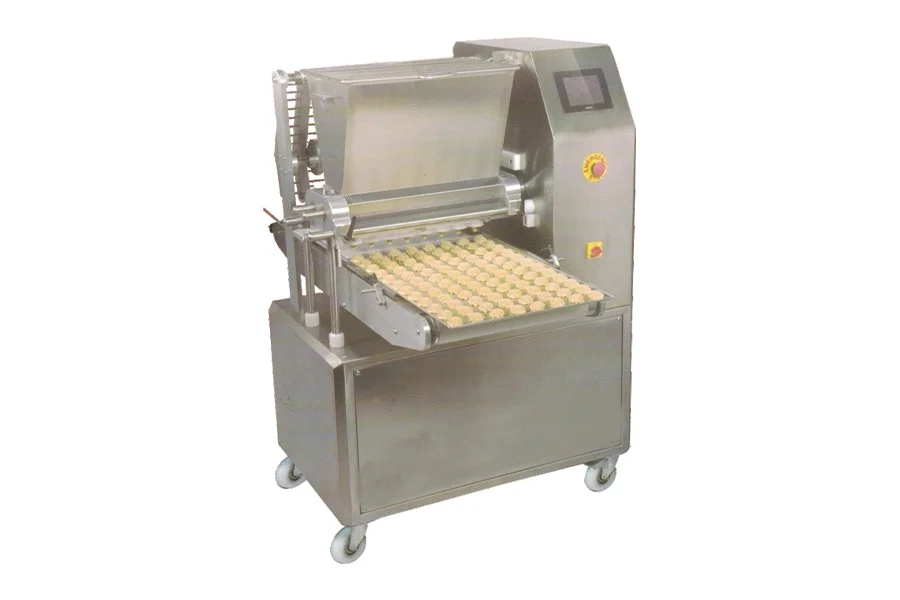- This topic is empty.
-
AuthorPosts
-
In today' s highly competitive food industry, commercial bakeries face increasing pressure to maximize production efficiency, maintain consistent product quality, and comply with strict hygiene standards. As a result, automation has become a key driver in modern baking operations. In this blog post, as a high performance automated baking equipment exporter, Baimai will share the application of automatic cookie machine in commercial baking, including advantages, components, etc.
1. Overview of Automatic Cookie Machine
An automatic cookie machine is a specialized piece of industrial equipment designed to automate various stages of cookie production, including dough forming, shaping, depositing, baking, and sometimes packaging. These machines come in various configurations and capacities, ranging from compact tabletop models for small-scale operations to high-capacity, fully-integrated production lines for large bakeries.
Automatic cookie machines generally fall into the following categories:
* Wire-cut cookie machines – Ideal for producing soft, dense cookies by extruding dough and slicing it with a wire.
* Depositor machines – Suitable for semi-liquid or soft doughs that are deposited directly onto baking trays.
* Rotary moulder machines – Used for hard dough types, pressing the dough into patterned molds.
* Encrusting machines – Designed to produce filled cookies with high precision.
Each machine type is engineered to handle specific dough consistencies, shapes, and production rates, making them integral to achieving large-scale cookie production with minimal human intervention.
2. Technical Components and Working Mechanism
Automatic cookie machines are composed of several key subsystems that work in coordination to automate the cookie production process. The primary technical components include:
a. Dough Feeder and Hopper
This component stores and feeds the dough into the shaping mechanism. In advanced systems, hoppers are equipped with agitators or chillers to maintain dough consistency and temperature, which is critical for the uniformity of final products.
b. Extrusion or Depositing Unit
Depending on the machine type, this unit either extrudes the dough through specific nozzles or deposits it in dollops onto the conveyor belt. Servo motors are typically employed for high-precision control over the volume and placement of the dough.
c. Cutting and Shaping Tools
Wire cutters, rotary molds, or stamping tools are used to shape the cookies into desired geometries. These tools can be customized and replaced based on the cookie design, allowing for versatile production lines.
d. Conveyor and Tray Management
Automated conveyors transport dough from the depositing station to the oven. Some systems include tray loading and unloading mechanisms that synchronize with the cookie deposition process to ensure continuous operation.
e. Baking Integration (Optional)
Advanced systems may be integrated with tunnel ovens that bake cookies inline, reducing handling time and potential contamination. Oven parameters such as temperature, humidity, and airflow are closely monitored for quality assurance.
f. PLC Control System
Programmable Logic Controllers (PLCs) govern the operation of the entire system, offering interfaces for parameter settings, recipe management, and real-time diagnostics. Human-Machine Interfaces (HMIs) facilitate user interaction for operators to manage different product runs with ease.
3. Benefits of Automatic Cookie Machine in Commercial Baking
a. Increased Production Efficiency
Automatic cookie machines can produce thousands of cookies per hour, dramatically surpassing manual or semi-manual methods. The use of multi-nozzle heads and high-speed servo controls enables continuous and fast production, reducing labor and time costs.
b. Consistent Quality and Precision
One of the critical challenges in baking is maintaining uniformity in size, weight, and texture. Automated machines ensure consistent portioning and shaping, which enhances brand reliability and customer satisfaction. Computer-controlled systems eliminate human error and variability.
c. Reduced Labor Dependency
Labor shortages and the high cost of skilled bakers have made automation a strategic necessity. With automatic machines, fewer operators are needed to supervise the line, and training is simplified due to intuitive HMIs.
d. Enhanced Hygiene and Safety
In the food industry, maintaining hygiene standards is paramount. Automatic cookie machines are constructed with food-grade stainless steel, hygienic design principles (e.g., minimal dead zones), and are often CIP (Clean-In-Place) compatible. They reduce human contact with the dough, minimizing the risk of contamination.
e. Scalability and Flexibility
Modern cookie machines are modular and configurable, allowing bakeries to scale operations or adapt to new product lines. Recipe storage, tool changeover, and digital control systems allow rapid adaptation to market demands without significant downtime.

4. Applications of Automatic Cookie Machine in Commercial Settings
Automatic cookie machines are used across a wide spectrum of commercial baking applications:
* Mass-production facilities – High-throughput machines are employed in factories producing packaged cookies for global distribution.
* Contract bakeries – Facilities manufacturing for private-label or third-party brands benefit from quick changeovers and versatility.
* Specialty and premium bakeries – These operations use automation to scale artisan-style cookies while maintaining hand-crafted quality via advanced mold designs and dough handling.
* Institutional baking (schools, airlines, hospitals) – Automated systems ensure standardized nutrition and allergen controls in large-volume operations.
Conclusion
The application of automatic cookie machines in commercial baking represents a transformative step toward scalable, hygienic, and consistent production. These machines embody the principles of precision engineering, automation, and smart manufacturing, offering commercial bakeries a competitive edge in efficiency, quality, and innovation. As technology evolves, the integration of digital tools, AI, and sustainability practices will further redefine what is possible in the world of commercial baking. For bakeries seeking to future-proof their operations, investing in automatic cookie machines is not just a choice—it' s a necessity.
http://www.bmbaking.com
Baimai -
AuthorPosts